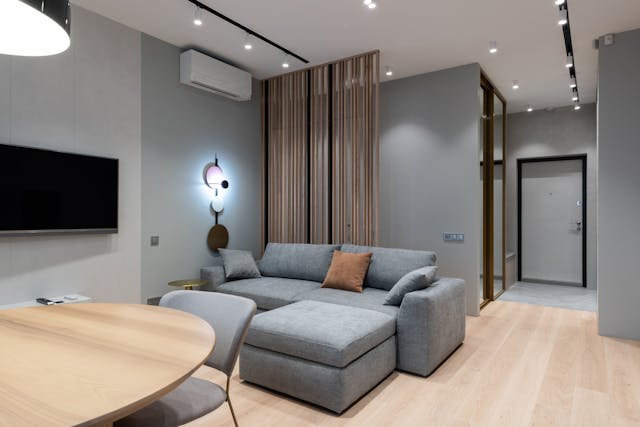
Vacancies are inevitable in the life of any landlord. A tenant may want to move for various reasons, from financial hardships to needing more space or unforeseen circumstances like job relocation, illness, or change in marital status.
Regardless of the reason, you must always have a plan to re-rent your property on the rental market quickly because you’ll lose money every day your property sits vacant. Here are eight tips from our property management company on how to get your property ready to rent:
1. List Your Property on Rental Listing Sites
Minimizing vacancy periods in your house is crucial for maximizing your rental income as a landlord. Advertise the property on as many relevant platforms as possible. Leverage prominent online listing platforms, along with social media groups used by potential renters.
Don't neglect traditional methods – a well-placed "For Rent" sign and strategic local advertisements can still yield qualified leads. Let current tenants know about the vacancy as word-of-mouth referrals often generate great leads when trying to rent out your rental unit.

When listing the property on the rental market, a landlord must stage the rental property to showcase its best features and create a sense of move-in readiness. Craft a compelling, yet concise rent description that highlights key details such as square footage, number of bedrooms and bathrooms, and unique amenities
2. Make Needed Repairs
As a landlord, you must provide a habitable rental property that meets basic safety and health codes when you rent out your unit. After a tenant moves out, consider making the following repairs to the rental unit:
Faded Paint: A fresh coat of paint in the house can revitalize the property’s overall look and appeal.
Malfunctioning Appliances: Test appliances around the house like dishwashers, ovens, refrigerators, and washing machines to ensure they are in good condition.
Plumbing Issues: Check for malfunctioning toilets, clogged drains, or leaking faucets in the house.
Electrical Issues: Look for damaged wiring, flickering lights, or faulty outlets.
3. Conduct a Property Walkthrough
Most landlords require tenants to return the property in the same move-in condition, minus normal wear and tear. Before the tenant moves in, the landlord must conduct a thorough walkthrough inspection together and document any existing damages.
Upon lease termination, schedule another walkthrough inspection with the tenant. Compare the current condition of the property to the move-in checklist and photos. Note any damages beyond normal wear and tear, such as unfilled nail holes, broken fixtures, or excessive carpet stains.
If you find damages beyond normal wear and tear, discuss them with the tenant. Provide them with a copy of the move-in checklist and photos for reference.
If they are responsible for repairs, they can choose to fix them themselves before moving or authorize deductions from their security deposit to cover the repair costs.
4. Clean the Property Thoroughly
To attract quality tenants when you rent out your unit, your rental property should be clean and neat. Ensure that you thoroughly clean the property before renting it out. If it is reasonably clean, you can handle the cleaning yourself.

However, if it looks like a horror scene, hire professional cleaning services. Professional cleaners have the skills, experience, and resources to guarantee top-notch results. Remember to deduct the cleaning costs from the tenant’s deposit if applicable.
5. Change the Keys After a Tenant Moves Out
For security reasons, it's highly recommended to rekey the locks after a tenant moves out. This ensures that only authorized individuals (new tenants and the landlord) have access to the property. Local laws or the lease agreement will determine who is responsible for the cost of rekeying.
6. Upgrade the Property
A vacancy allows a landlord to do house renovations uninterrupted. So, which upgrades should you consider for your rental property? Consider the following list:
Boost Curb Appeal: Enhance the exterior to make a good first impression.
Revitalize the Kitchen: Repaint cabinets, swap out old fixtures, or add new hardware.
Go Tech-Savvy: Add features like in-unit laundry, app-controlled locks, and smart thermostats.
Go Green: Install energy-efficient appliances to attract environmentally-minded tenants.
Add More Space: Convert unused spaces like the basement or attic into extra living areas, potentially raising your rental income.
7. Check for the Presence of Mold
Mold growth can pose a health risk to tenants and deter potential renters. After a tenant moves out, inspect the property thoroughly for mold, especially in high-moisture areas like kitchens, bathrooms, and basements.
Look for visible mold growth, a musty smell, signs of water damage, or if the tenant reported any respiratory problems during their tenancy.
If you discover mold, prompt action is crucial. Depending on the severity, professional remediation may be necessary. Always prioritize the health and safety of your tenants and future occupants.
8. Test the Functionality of HVAC Systems
HVAC systems are critical for maintaining a habitable property. Ensure your heating, ventilation, and cooling systems are working correctly. Signs of malfunction include uneven cooling or heating, strange noises, odors, reduced airflow, and leaks.

If you notice any of these issues before your rent out the unit, get in touch with an HVAC technician right away. Early intervention can help prevent serious and potentially costly issues later down the road.
Bottom Line
Preparing your property for new renters requires effort and time, but these tips can help you rent out your property much faster and attract great tenants for optimum ROI.
For expert help to rent out your house, look no further than KRS Holdings (Richmond Area). You can count on KRS Holdings for reliable property management services, performance, and responsiveness. Get in touch with our property manager team to get started!






